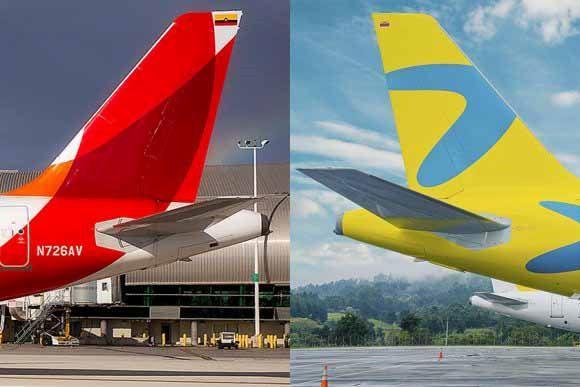
This week’s top air transport stories include Avianca withdrew its effort to acquire Viva Air and a possible Turkish Airlines order for 600 aircraft in June.
Avianca withdrew its effort to acquire Viva Air, saying Colombian regulator Aerocivil’s conditions for approving the proposed merger would “make Viva’s recovery impossible and could even affect Avianca’s stability.” Avianca said in a May 13 statement that the “shortcomings” of Aerocivil’s resolution outlining conditions for clearing its acquisition of the Colombian ULCC “are numerous.”
Turkish Airlines expects to announce an order for 600 aircraft in June, part of the airline’s plans to expand its fleet to over 800 aircraft by 2033. “Currently, we have 414 aircraft in our fleet and are aiming to reach 435 aircraft by the end of this year,” Turkish Airlines Chairman of the Board and Executive Committee Ahmet Bolat told Aviation Daily.
In other aircraft news, Singapore Airlines (SIA) reached an agreement with Boeing to swap three 787-9s for three 787-10s, and will cancel eight 737-8s, as part of its long-term fleet renewal strategy. SIA says the Boeing order adjustments are to support its projected operational requirements.
In airline news, Canada’s WestJet flights could be grounded by May 19, as contract negotiations between pilots and the airline continue. The Calgary-based carrier’s pilots, represented by the Air Line Pilots Association (ALPA), issued a 72-hour strike notice on the evening of May 15. In response, the notice was followed by a company-issued 72-hour lockout notification. As a result, a work stoppage could begin as soon as 3 a.m. MT on Friday, May 19.
Brazilian operator Azul reached an agreement with the majority of its lessors to reduce its lease payments by BRL5.4 billion ($1.1 billion) during the next four-and-a-half years as part of its restructuring process.
In sustainability news, A U.S.-Belgian startup—Cosmic Aerospace—has emerged from stealth to pursue development of a small all-electric airliner with an unconventional airframe-engine integration designed to enable longer range on batteries. Cosmic Aerospace was founded by Brussels-based Christopher Chahine, a former researcher at the von Karman Institute for Fluid Dynamics, with Denver-based Joe Wilding and Marshall Gusman, both formerly with supersonic aircraft startup Boom Technology. Cosmic’s 25-seat aircraft has multiple electric jet engines embedded in a lightweight, long-span wing to reduce drag and energy consumption and enable a range of 1,000 km (620 mi.) plus reserves.
Airbus signed an MOU with Abu Dhabi Future Energy company Masdar to support the development and growth of the global sustainable aviation fuel (SAF) market. The agreement highlights areas of collaboration, including SAFs, green hydrogen and direct air capture technologies, as well as supporting the development and implementation of book-and-claim solutions.
Boeing is asking suppliers for help defining a sustainable aviation fuel (SAF) type fluid for testing a wide range of components from simple seals to entire engines. Boeing says the tests will be essential to clearing the use of SAF at 100% because, unlike conventional petroleum-based jet fuel, the synthetic fuel does not always have the aromatics and heteroatomic compounds which help seal connections, valves, pipes and gaskets in today’s aircraft and engines.
German aerospace center DLR plans to build a flying laboratory open to industry and research partners to accelerate flight testing of propulsion, fuel and system technologies for the decarbonization of aviation. BMWK, the Federal Ministry for Economic Affairs and Climate Affairs, provided €45.2 million ($49 million) in funding over three years under its LuFo Klima national aviation research program to acquire and convert the aircraft. First flight tests are planned as early as 2024.
Seoul’s metropolitan government has selected routes for urban air mobility (UAM) demonstration flights in 2024-25 as part of South Korea’s K-UAM Grand Challenge, which is intended to commercialize urban air taxi flights in Korea by 2025.
Finally, in airport news, construction work has started on a third terminal at Taiyuan Wusu Airport (TYN) in China’s Shanxi province. The phase three project will add a 400,000 sq m (4.3 million sq. ft.) terminal, 3,126 more aircraft stands, and a second runway. The aim is to increase the airport’s handling capacity to 40 million passengers and 300,000 tons of cargo annually. This phase will also include a 50,000 sq m transportation center. The terminal is designed to resemble a “soaring eagle” with a 1,497 m (4,900 ft.) central corridor and three finger piers, the longest at 256 meters.
Miami International Airport (MIA) will open a “luxury terminal” for commercial flights at Pan American Airways’ former regional headquarters building at MIA.
Dallas/Fort Worth International Airport (DFW) and American Airlines signed a new 10-year use and lease agreement that revives plans to build a sixth terminal at DFW. The new Terminal F will cost an estimated $1.63 billion to build and include 15 gates. The airport is aiming for Terminal F to open in 2026.
